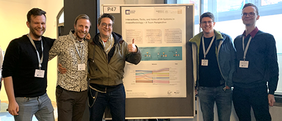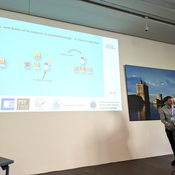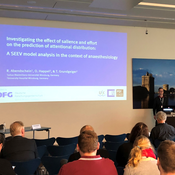PsyErgo auf der HFESE‘24
13.05.2024Bei der Human Factors and Ergonomics Society – Europe Chapter (HFESE)-Konferenz treffen sich europäische Forscherinnen und Forscher und diskutieren zu verschiedensten Themen in den Bereichen Human Factors und Ergonomie. Die diesjährige Konferenz in der Hansestadt Lübeck vom 17.-19. April beschäftigte sich unter anderem mit den Themen Human-AI Interaction, Human Factors in verschiedenen Kontexten wie z.B. in Luft-, Schifffahrt, im Schienenverkehr oder auf der Straße sowie mit Methodenforschung.
Vom Lehrstuhl für Psychologische Ergonomie nahmen Tobias Grundgeiger, Stephan Huber und Robin Abendschein zusammen mit dem Kooperationspartner Oliver Happel vom Universitätsklinikum Würzburg teil und tauschten sich innerhalb der Forschungscommunity aus. Sie stellten dabei in zwei Beiträgen Erkenntnisse aus aktuellen Projekten vor:
Robin Abendschein präsentierte unter dem Titel „Investigating the effect of salience and effort on the prediction of attentional distribution: A SEEV model analysis in the context of anaesthesiology” methodische Erkenntnisse zum SEEV Modell aus dem Projekt Modellierung von Aufmerksamkeit und Situationsbewusstsein in der Akutmedizin. Zum Themenbereich Human-AI Interaction präsentierte Stephan Huber das Poster „Interactions, Tasks, and Roles of AI-Systems in Anaesthesiology – A Team Perspective” aus dem Projekt CASSANDRA hört zu und hilft: Ein KI-Teammitglied für die Anästhesiologie.
ABSTRACTS
Investigating the effect of salience and effort on the prediction of attentional distribution: A SEEV
model analysis in the context of anaesthesiology
Anaesthesiologists monitor changes in their patients’ conditions for appropriate care during the induction of general anaesthesia. The Salience Effort Expectancy Value (SEEV) model can be used to predict the allocation of visual attention during such tasks. However, most studies have investigated the predictive power of the model (model fit) by employing only the factors expectancy and value (EV model). Initial findings regarding the usefulness of the salience factor are mixed. In the present study, we investigated the predictive power of the SEEV model in the context of anaesthesiology with different combinations of the four model parameters (EV, S-EV, E-EV, S-E-EV). We obtained the highest model fits for the EV (r = 0.88) and the S-EV (r = 0.87) model. Our findings indicate that complementing the EV model by the parameter salience does not improve model predictions and that adding the effort parameter even deteriorates predictions in the context of anaesthesiology. Future research needs to improve the validity of salience and effort measures and should expand these findings on different scenarios and domains.
Interactions, Tasks, and Roles of AI-Systems in Anaesthesiology – A Team Perspective
When referring to the role of newly proposed clinical applications of artificial intelligence (AI), recent work frequently used the term “human-AI team” to highlight the social role and effects of AI systems. However, AI systems have been developed to support anaesthesiologists for approximately four decades. In this work, we conducted a systematic literature review on AI systems in anaesthesiology and identify the spectrum of the role of AI within anaesthesia teams. In 49 included papers, we found a role spectrum ranging from minor task execution (e.g., detection of signals), over management and guidance (e.g.,
conveying spatial and timely orientation) to planning (e.g., prediction of conditions and evaluation of existing plans), decision support (e.g., reminders and reasoning), and automation (e.g., closed loop systems with full agency). The review showed, that despite a focus on task-orientation during the AI development, the functionality of each AI system entails a social role that prescribes how human team members interact with the system. However, the impact of the technology’s social role within the team was rarely reflected.
We call for conscious design decisions on the social role of artificial team members in human-AI teams along with the development of new methods that aid the design.
REFERENCES
Abendschein, R., Happel, O., & Grundgeiger, T. (2024). Investigating the effect of salience and effort on the prediction of attentional distribution: A SEEV model analysis in the context of anaesthesiology. Presentation at the Human Factors and Ergonomics Society Europe Chapter Annual Meeting 2024, Lübeck, Germany. https://www.hfese24.de/fileadmin/Files/Projects/03_HFESE/AbstractsL%C3%BCbeck2024.pdf
Huber, S., Happel, O., & Grundgeiger, T. (2024). Interactions, Tasks, and Roles of AI-Systems in Anaesthesiology – A Team Perspective. Poster presented at the Human Factors and Ergonomics Society Europe Chapter Annual Meeting 2024, Lübeck, Germany. https://www.hfese24.de/fileadmin/Files/Projects/03_HFESE/AbstractsL%C3%BCbeck2024.pdf






